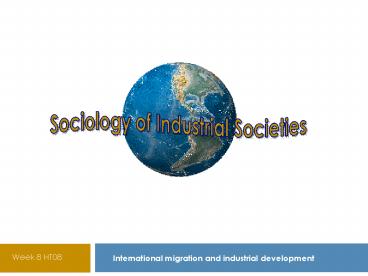Week 8 HT08 - PowerPoint PPT Presentation
1 / 12
Title: Week 8 HT08
1
Sociology of Industrial Societies
International migration and industrial development
Week 8 HT08
2
International migration and industrial
development
- Lecture plan
- Historical trends in international migration
- Contemporary patterns of international migration
- The drivers of contemporary international
migration flows - Forces pushing people to migrate away from
developing countries - Forces pulling migrants towards industrial
societies - The perpetuation of international migration flows
International migration and industrial development
Week 8 HT08
3
Historical trends in international migration the
colonial era
- Large-scale migration during the colonial era
- of European colonizers, esp. to Americas, also
Oceania Africa - of enslaved Africans and indentured Asian
labourers, esp. to North America
Source Castles and Miller 2003
International migration and industrial development
Week 8 HT08
4
Historical trends in international migration
industrial era
- Continued migration during industrial era
- within Europe, and from Europe to the Americas
during industrialization - then to Europe, esp. from Asia and North Africa
during period of full-on industrialism
Source Castles and Miller 2003
International migration and industrial development
Week 8 HT08
5
Historical trends in international migration
global era
- Migration flows stronger than ever in global era
- to North America, esp. from Central and South
America, and China - to Europe from former colonies in S. America,
Caribbean, India, N. Africa
Source Castles and Miller 2003
International migration and industrial development
Week 8 HT08
6
Contemporary patterns of international migration
- Substantial migration away from developing and
towards developed world post-WWII
Source United Nations 2004
International migration and industrial development
Week 8 HT08
7
Contemporary patterns of international migration
- Migration projections indicate
- continued movement from industrializing to
industrialized world - Major countries of net immigration those in North
America, Europe and Oceania - Major countries of net emigration those in
Central America and Asia
Source United Nations 2004
International migration and industrial development
Week 8 HT08
8
Contemporary patterns of international migration
- Immigration growth means increasingly diverse
populations of industrial societies
Source Migration Information Source
International migration and industrial development
Week 8 HT08
9
Drivers of international migration push forces
- Global spread of trade and industrialization
pushes workers in developing societies to
migrate - World systems theory (e.g. Wallerstein 1976)
- Dialectical interaction between industrialized
core and pre-industrial/industrializing periphery - Spread of industrial capitalism through trade and
investment disrupts and transforms existing
social/economic arrangements in peripheral
societies - Development means displacement of people from
their customary livelihoods, and creation of
mobile population of workers actively searching
for new ways of earning income, managing risk and
acquiring capital - Neoclassical macroeconomic theory
- (e.g. Lewis 1954)
- Low wages in developing countries because
- large supply of labour relative to capital
- High wages in developed countries because
- limited supply of labour relative to capital
International migration and industrial development
Week 8 HT08
10
Drivers of international migration pull forces
- Post-industrial transformations in advanced
industrial societies pull in migrant workers - Neoclassical microeconomics (e.g. Todaro 1969)
- Workers decide to migrate on basis of calculation
of comparative utility of migration versus
staying put P(B-C) - New economics of labour migration (e.g. Stark and
Bloom 1985) - Minimal insurance and credit systems in
developing countries requires collective strategy
to manage risk and gain access to capital as well
as to maximize income - Households diversify their labour portfolios by
sending - members to work abroad
- Dual labour market theory (e.g. Piore 1979)
- Advanced industrial societies tend towards
bifurcated - labour markets high-wage jobs in primary
sector, and - low-wage jobs in secondary sector
International migration and industrial development
Week 8 HT08
11
The perpetuation of international migration flows
- Migration flows tend to create conditions
favourable to their perpetuation - Cumulative causation theory (e.g. Myrdal 1957)
- in sending country, emigration promotes feelings
of relative deprivation, changes peoples tastes
and motivations at individual/community level,
reduces demand for agricultural labour, depletes
human capital - in receiving country, immigration
- reinforces labelling of low-wage
- jobs as immigrant jobs and
- thus demand for immigrants to
- fill them
- Social capital theory
- (e.g. Massey et al 1987)
- Migrant networks and ties
- provide valuable sources of
- information and assistance,
- modifying P(B-C) calculation
Source Palloni et al 2001
International migration and industrial development
Week 8 HT08
12
International migration and industrial
development
- International migration reshapes the globe
World map showing territory size relative to net
immigration in 2000
Source Worldmapper.org
International migration and industrial development
Week 8 HT08































